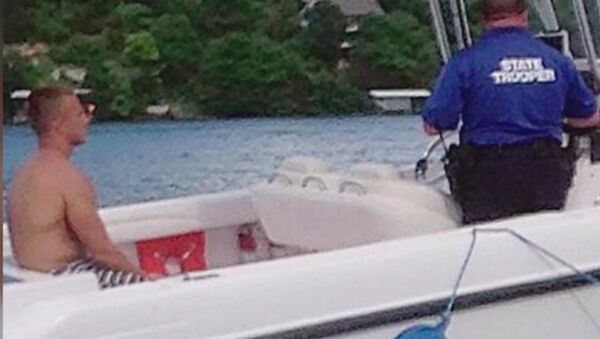Special prosecutor William Camm Seay announced the charge against trooper Anthony Piercy on Friday. Piercy turned himself in to Moniteau County authorities later that day.
The charge came after an 18 month investigation following accusations that Piercy tried to cover up details about the tragedy.
The incident began on May 31, 2014, when Ellington was spending a weekend at Lake of the Ozarks with friends. Piercy, patrolling the lake, encountered Ellington and arrested him for boating while intoxicated.
Records show Ellington’s blood-alcohol level was.268, or about three times the legal limit.
Prosecutor: Missouri trooper ‘recklessly’ caused Brandon Ellingson’s death https://t.co/DaEArNldaX pic.twitter.com/aeDG462J0s
— WHO-HD Ch. 13 News (@WHOhd) December 19, 2015
Ellingson's friends say Piercy handcuffed Ellingson, and put a life vest on him without securing it to his body. The vest was a Type III jacket with arm holes, and cannot be secured on a person with hands tied behind their back. A Type I flotation device, which was available to be secured on Ellingson by Piercy, was not used.
Following the arrest, Piercy drove his boat to a patrol zone office about 8
miles away. GPS records show his boat reached a maximum speed of 46 mph and, during the journey, Ellington’s vest came off of his body and he fell into the water, where he drowned.
After noticing Ellingson had fallen overboard, Piercy brought the boat around, and jumped into the water, but was unable to save him.
Divers recovered the body the following day from the bottom of the lake.
Craig Ellingson said he felt some relief Friday when trooper was charged. "But we still have to get him convicted." pic.twitter.com/eVWV1LpkTm
— Laura Bauer (@kclaurab) December 18, 2015
Following the inquest, jurors concluded the death was accidental. Special prosecutor Amanda Grellner announced that she would not file criminal charges against Piercy.
Grellner then re-opened the case in January, citing new evidence, but stepped down in March claiming an unidentified conflict of interest, and Seay stepped in.
Details surrounding the case have remained contentious.
On the night of the drowning, Piercy called the on-duty sergeant, Randy Henry to describe the situation.
Henry, who retired after being demoted and transferred for actions relating to the case, said Piercy’s account to him of the incident sharply differed from the one he gave to Highway Patrol investigators and jurors.
According to Henry, Piercy told the sergeant that he had jumped into the water – a moment which witnesses said took several minutes — and waited for his fanny-pack flotation device to automatically deploy. Henry told him his fanny pack had a cord that needed to be pulled to deploy the flotation device.
At the inquest, Piercy told jurors he didn’t want to pull it for fear of floating to the top and being unable to retrieve the man’s body.
Many people questioned the amount time it took for Piercy to respond and dive into the water. Witnesses who were by the lake claimed they saw the trooper’s boat and saw the trooper talking to a man in the water bobbing on the surface.
“I think his failure to jump in immediately was cowardice,” Henry told The Kansas City Star newspaper. “If I threw somebody out and he was handcuffed and I see the life vest come off, you jump in now. You go in immediately.”
Most of the evidence presented in the investigation pointed to the improper training of Piercy, a potential side effect of a 2011 merger between regular State Troopers and water-based law enforcement in the state.
Records show Piercy had a total of two days of training on the water before he was allowed to patrol alone.
Henry, who signed off on Piercy being ready for solo aquatic patrol, stated that he never intended to allow Piercy to work solo without further training.
“Brandon shouldn’t have died,” Henry told The Star. “It’s something I’m going to have to live with the rest of my life. There’s no turning the page back. Piercy shouldn’t have been out there.”
Henry called events following the incident a “cover up” to protect the governor and his support of the budget-saving merger.
“There’s been a cover-up from the beginning,” Henry told The Star. “They wanted to protect the governor and the merger, and protect Piercy from criminal charges because criminal charges would be a black eye for the patrol.”
The incident led to several months of meetings involving a special committee, which earlier this year released a report urging the state to address issues raised by the law-enforcement merger.
“Knowing that this didn’t have to happen will always be there,” said Brandon’s mother Sherry Ellingson. “But his death exposed somebody who shouldn’t be in that position to begin with. And it exposed inadequacies in the system.
“His death had to mean something, and it did,” she said.





